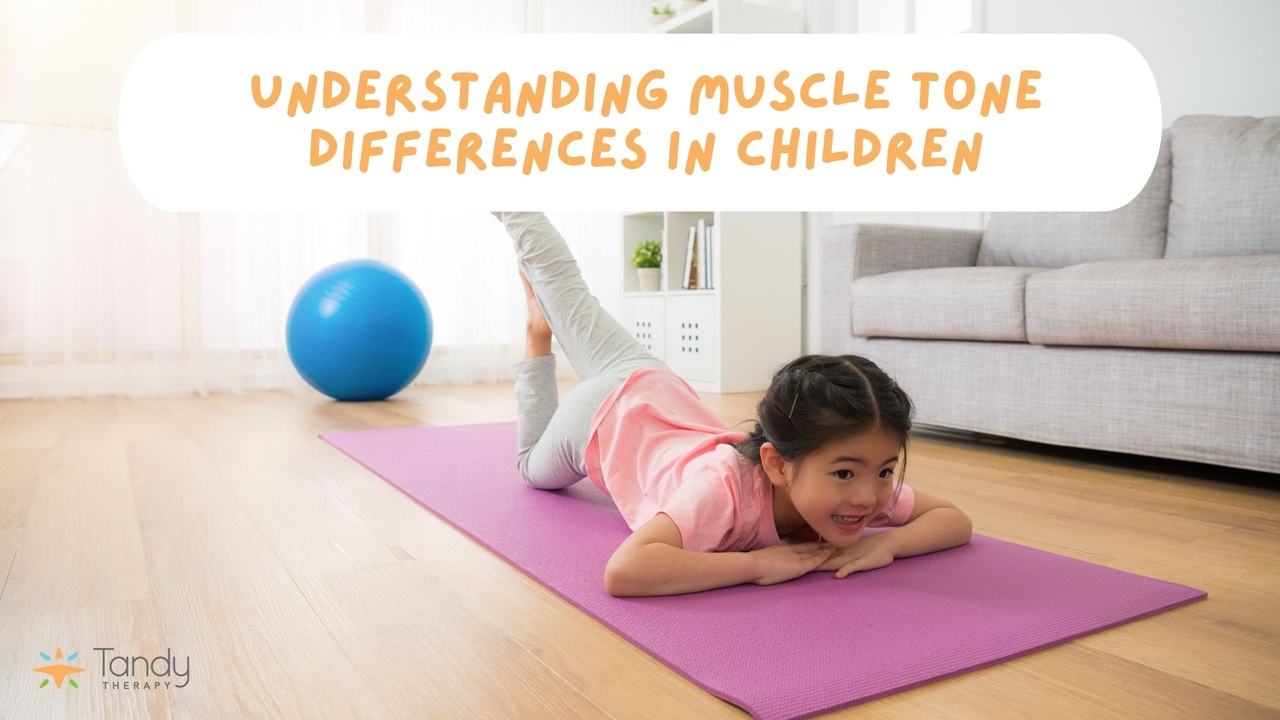Understanding Muscle Tone Differences in Children
Oct 25, 2021
Before understanding how muscle tone impacts children, it is important to understand the general idea of muscle tone. Muscle tone can be defined on a basic level as the amount of tension in our muscles when they are at rest. Even when our muscles are at rest, there is always a level of a passive activity in our muscles. Muscle tone provides joint stability and integrity, postural stability, and provides your brain with proprioceptive information or where your joints and extremities are located.
In typical adults and children, there is a continuum of normal muscle tone ranging from high tone to low tone. Some diagnoses can further impact muscle tone causing a child’s tone to fall outside of the normal range and into either the high or low tone categories--the activities and descriptions in this article will not apply to these children. Children with higher normal tone tend to be less flexible, appear more coordinated, and be able to engage in gross motor activities for longer periods of time. Children with lower normal tone will often appear more flexible, get tired more easily, and have more difficulty coordinating movements against gravity.
Muscle tone differences are most often evident in infants and although a child’s natural resting muscle tone may never change, as the child’s coordination and strength improve, the low muscle tone will have less of an impact the older they get.
If your child demonstrates lower normal muscle tone, there are some activities you can do to promote increased strength and coordination.
- Animal Walks: Crab, bear, frog, bunny hops, etc. The possibilities are endless!
- Prone Activities: Playing a puzzle laying on their stomach, pretending to swim on the ground, lifting arms to fly like an airplane while on their stomach.
- Try Kid’s Yoga: There are various resources you can find for this by search kid’s yoga on YouTube. Some of the videos are fun and include stories with yoga poses.
- Pushing/Pulling: Fill a basket or box with heavy items and encourage your child to push or pull it around the house. You can turn it into a relay race and have them play with a sibling.
- Wheelbarrow Walks: Have your child walk on their hands while you hold them at their hips, thighs, or ankles.
- Tug of War: Encourage your child to play tug of war with you, a sibling, or a pet. They can play tug of war in a sitting or standing position depending on their ability to balance.
Children with a low normal tone can achieve impressive physical strength and endurance; however, it may take more time and require extra time, patience, and effort. You can use some of the above activities as a warm-up everyday to help improve your child’s endurance and activate their muscles before physically demanding tasks. For example, if you notice your child having difficulty sitting up at the table while doing a fine motor task you may ask them to stand up and jump on a trampoline or do jumping jacks. Using the trampoline or jumping jacks as a warm-up task will help your child’s muscles activate and will often improve their posture when they return to sitting at the table.
If you have concerns about your child’s gross motor development, be sure to talk to your primary care doctor and discuss whether or not a referral to occupational or physical therapy might be helpful.
Occupational Therapy
Individual therapy is currently being offered as a hybrid model including a mix of both telehealth and in-person services based on the individual needs of the child and their family. Our occupational therapists evaluate and treat children to improve their independence and develop the skills they need to participate in their daily “occupations” such as self-care activities, playing, learning, and participating in social settings. We utilize family coaching and play-based therapy to engage children in purposeful activities to improve sensory integration, fine motor, visual motor, cognitive, self-regulation, oral, and feeding skills. The goal of pediatric occupational therapy is not only to help children adequately progress but to challenge them appropriately, helping to build self-esteem and confidence in their capabilities. Occupational therapists can address the following:
- Sensory Processing
- Play and Motor Skills
- Self-Care Skills
- Fine Motor Skills
- Social Participation
- Parent/Caregiver Education
- Fine Motor/Social/Self-Care Developmental Milestones
Contact us to learn more!
Tel: 208-981-1111
Email: [email protected]
Your Guide to Getting Started in Telepractice (For Clinicians)
Do you feel prepared for your teletherapy sessions? Are your clients prepared and feeling confident in their ability to effectively participate? This packet is designed to make sure you and your clients are ready for each session. These easy-to-use checklists will ensure you don't forget any of the steps and keep your session set-up efficient.
Like us on Facebook, Tandy Therapy Box LLC: https://www.facebook.com/tandytherapybox
Follow us on Instagram: https://www.instagram.com/tandytherapy/
About the Author
Serena Dewey is an occupational therapist, was born and raised in western Washington but has lived throughout the northwest. She completed her bachelor's degree at Walla Walla University in Speech Communication and then completed her master's degree in Occupational Therapy at Eastern Washington University. While at Eastern Washington University, Serena participated in community-based volunteer opportunities including the organization of a Halloween costume design and trick-or-treating event for children with mobility limitations. Serena also enjoyed partnering with children and their families during a constraint-induced movement therapy camp offered at Eastern Washington University. She has experience working in a variety of settings including inpatient rehabilitation, mental health, pediatrics, early intervention pediatrics, and telehealth.

